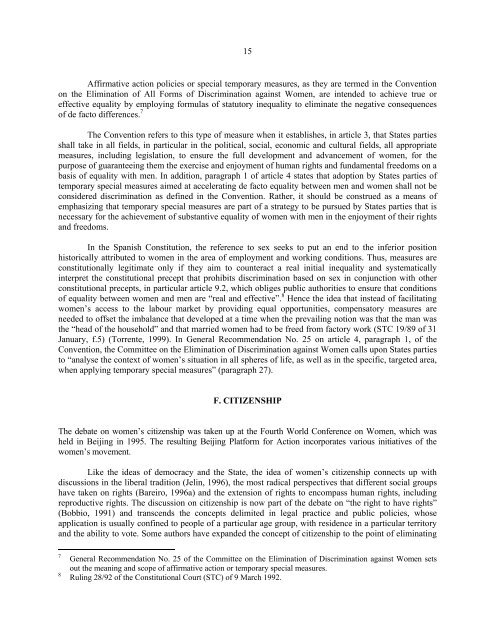Women in Latin America and the Caribbean - Cepal
Women in Latin America and the Caribbean - Cepal
Women in Latin America and the Caribbean - Cepal
Create successful ePaper yourself
Turn your PDF publications into a flip-book with our unique Google optimized e-Paper software.
15<br />
Affirmative action policies or special temporary measures, as <strong>the</strong>y are termed <strong>in</strong> <strong>the</strong> Convention<br />
on <strong>the</strong> Elim<strong>in</strong>ation of All Forms of Discrim<strong>in</strong>ation aga<strong>in</strong>st <strong>Women</strong>, are <strong>in</strong>tended to achieve true or<br />
effective equality by employ<strong>in</strong>g formulas of statutory <strong>in</strong>equality to elim<strong>in</strong>ate <strong>the</strong> negative consequences<br />
of de facto differences. 7<br />
The Convention refers to this type of measure when it establishes, <strong>in</strong> article 3, that States parties<br />
shall take <strong>in</strong> all fields, <strong>in</strong> particular <strong>in</strong> <strong>the</strong> political, social, economic <strong>and</strong> cultural fields, all appropriate<br />
measures, <strong>in</strong>clud<strong>in</strong>g legislation, to ensure <strong>the</strong> full development <strong>and</strong> advancement of women, for <strong>the</strong><br />
purpose of guarantee<strong>in</strong>g <strong>the</strong>m <strong>the</strong> exercise <strong>and</strong> enjoyment of human rights <strong>and</strong> fundamental freedoms on a<br />
basis of equality with men. In addition, paragraph 1 of article 4 states that adoption by States parties of<br />
temporary special measures aimed at accelerat<strong>in</strong>g de facto equality between men <strong>and</strong> women shall not be<br />
considered discrim<strong>in</strong>ation as def<strong>in</strong>ed <strong>in</strong> <strong>the</strong> Convention. Ra<strong>the</strong>r, it should be construed as a means of<br />
emphasiz<strong>in</strong>g that temporary special measures are part of a strategy to be pursued by States parties that is<br />
necessary for <strong>the</strong> achievement of substantive equality of women with men <strong>in</strong> <strong>the</strong> enjoyment of <strong>the</strong>ir rights<br />
<strong>and</strong> freedoms.<br />
In <strong>the</strong> Spanish Constitution, <strong>the</strong> reference to sex seeks to put an end to <strong>the</strong> <strong>in</strong>ferior position<br />
historically attributed to women <strong>in</strong> <strong>the</strong> area of employment <strong>and</strong> work<strong>in</strong>g conditions. Thus, measures are<br />
constitutionally legitimate only if <strong>the</strong>y aim to counteract a real <strong>in</strong>itial <strong>in</strong>equality <strong>and</strong> systematically<br />
<strong>in</strong>terpret <strong>the</strong> constitutional precept that prohibits discrim<strong>in</strong>ation based on sex <strong>in</strong> conjunction with o<strong>the</strong>r<br />
constitutional precepts, <strong>in</strong> particular article 9.2, which obliges public authorities to ensure that conditions<br />
of equality between women <strong>and</strong> men are “real <strong>and</strong> effective”. 8 Hence <strong>the</strong> idea that <strong>in</strong>stead of facilitat<strong>in</strong>g<br />
women’s access to <strong>the</strong> labour market by provid<strong>in</strong>g equal opportunities, compensatory measures are<br />
needed to offset <strong>the</strong> imbalance that developed at a time when <strong>the</strong> prevail<strong>in</strong>g notion was that <strong>the</strong> man was<br />
<strong>the</strong> “head of <strong>the</strong> household” <strong>and</strong> that married women had to be freed from factory work (STC 19/89 of 31<br />
January, f.5) (Torrente, 1999). In General Recommendation No. 25 on article 4, paragraph 1, of <strong>the</strong><br />
Convention, <strong>the</strong> Committee on <strong>the</strong> Elim<strong>in</strong>ation of Discrim<strong>in</strong>ation aga<strong>in</strong>st <strong>Women</strong> calls upon States parties<br />
to “analyse <strong>the</strong> context of women’s situation <strong>in</strong> all spheres of life, as well as <strong>in</strong> <strong>the</strong> specific, targeted area,<br />
when apply<strong>in</strong>g temporary special measures” (paragraph 27).<br />
F. CITIZENSHIP<br />
The debate on women’s citizenship was taken up at <strong>the</strong> Fourth World Conference on <strong>Women</strong>, which was<br />
held <strong>in</strong> Beij<strong>in</strong>g <strong>in</strong> 1995. The result<strong>in</strong>g Beij<strong>in</strong>g Platform for Action <strong>in</strong>corporates various <strong>in</strong>itiatives of <strong>the</strong><br />
women’s movement.<br />
Like <strong>the</strong> ideas of democracy <strong>and</strong> <strong>the</strong> State, <strong>the</strong> idea of women’s citizenship connects up with<br />
discussions <strong>in</strong> <strong>the</strong> liberal tradition (Jel<strong>in</strong>, 1996), <strong>the</strong> most radical perspectives that different social groups<br />
have taken on rights (Bareiro, 1996a) <strong>and</strong> <strong>the</strong> extension of rights to encompass human rights, <strong>in</strong>clud<strong>in</strong>g<br />
reproductive rights. The discussion on citizenship is now part of <strong>the</strong> debate on “<strong>the</strong> right to have rights”<br />
(Bobbio, 1991) <strong>and</strong> transcends <strong>the</strong> concepts delimited <strong>in</strong> legal practice <strong>and</strong> public policies, whose<br />
application is usually conf<strong>in</strong>ed to people of a particular age group, with residence <strong>in</strong> a particular territory<br />
<strong>and</strong> <strong>the</strong> ability to vote. Some authors have exp<strong>and</strong>ed <strong>the</strong> concept of citizenship to <strong>the</strong> po<strong>in</strong>t of elim<strong>in</strong>at<strong>in</strong>g<br />
7<br />
8<br />
General Recommendation No. 25 of <strong>the</strong> Committee on <strong>the</strong> Elim<strong>in</strong>ation of Discrim<strong>in</strong>ation aga<strong>in</strong>st <strong>Women</strong> sets<br />
out <strong>the</strong> mean<strong>in</strong>g <strong>and</strong> scope of affirmative action or temporary special measures.<br />
Rul<strong>in</strong>g 28/92 of <strong>the</strong> Constitutional Court (STC) of 9 March 1992.











